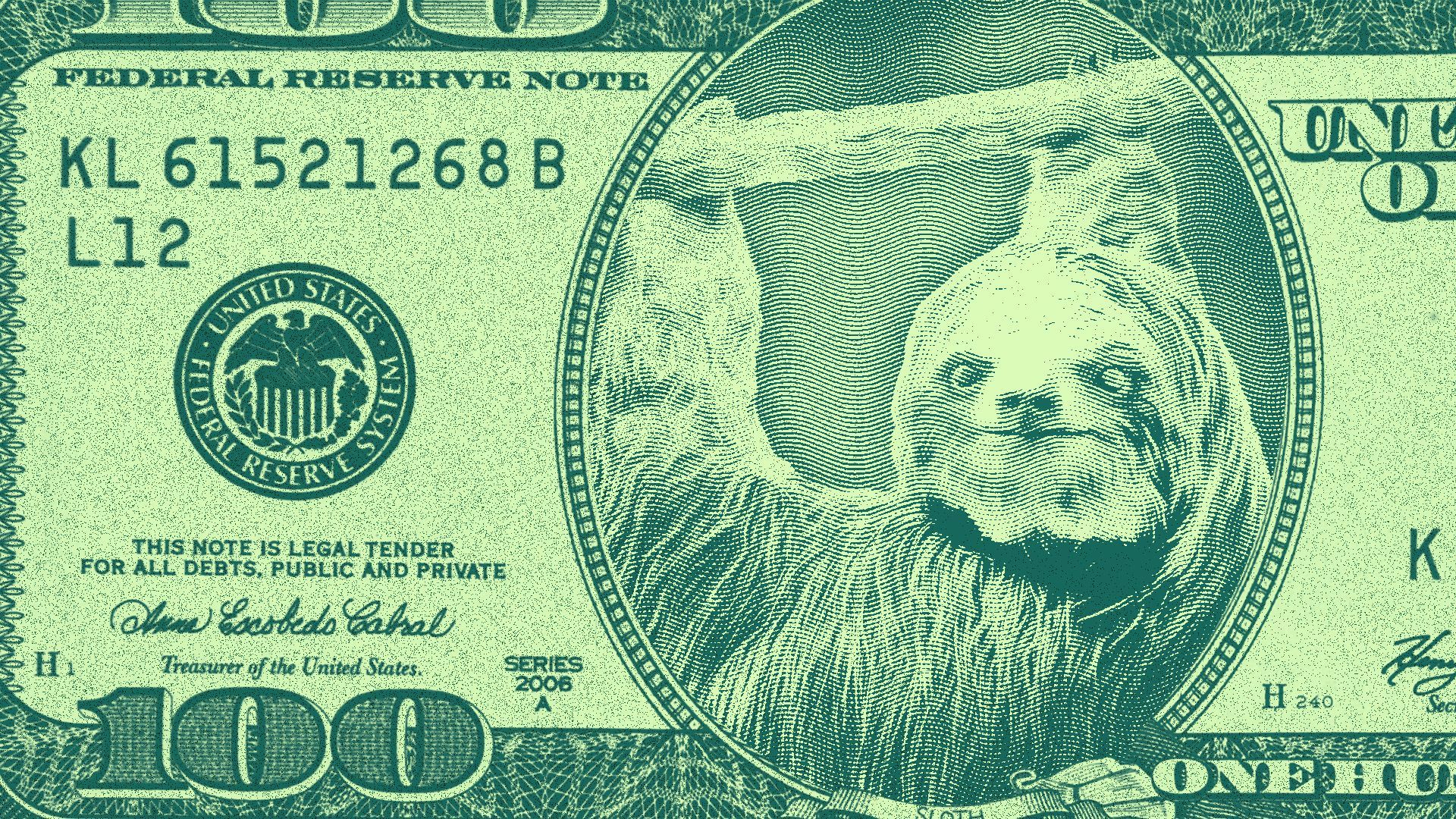The laziness tax

Illustration: Brendan Lynch/Axios
When it comes to investing, laziness is, broadly, a good thing. If you buy boring index funds and then just do nothing for many years, you are likely to outperform the vast majority of active traders.
Yes, but: When it comes to banking, laziness is likely to cost you.
Why it matters: Now that interest rates are no longer at zero, there's real money to be made by earning interest on your cash. But in order to do that, you probably need to open up a brand new account and move money into it.
The big picture: An ideal world for consumers would have exactly one smart bank account. It would be able to anticipate your regular paychecks, it would be able to keep real-time tabs on your credit card spending, and it would ensure a constant level of cash to be able to pay for all day-to-day expenses, including big items like mortgage payments.
- That cash would accrue interest at an attractive market rate.
- If there wasn't enough cash in the account to meet requirements, the customer would automatically borrow from the most attractive loan providers on the market. When there was excess cash, it would automatically get invested into a securities portfolio tailored to the customer's individual risk profile.
Between the lines: This vision, sometimes called "self-driving money," is unattractive to banks precisely because it's attractive to consumers. Banks make money when their customers have too much or too little cash in their checking accounts, or when they fail to keep on top of which new accounts they need to open in order to optimize their personal finances.
Driving the news: Apple made a big splash this week when it launched a new savings account, housed at Goldman Sachs.
- Where it stands: Millions of Apple customers already have an Apple-branded bank account, at Green Dot bank; it houses their Apple Cash, and pays no interest.
- Lazy Apple customers who do nothing will continue to receive no interest; active rate-shoppers, on the other hand, will be able to get 4.15% on their money.
- Customers also have to stay on top of which money is where: Apple Savings money, for instance, can't be used to pay Apple Card bills. Savers first need to transfer the cash to a checking or Apple Cash account, and thence use it to pay off their credit card.
How it works: Apple is reinventing the same business model that banks have used for decades — which is to use eye-grabbing interest rates to attract shoppers willing to move their money in search of yield, while trying to avoid paying those rates to existing customers.
- As American Banker reported in February, banks including Citi, PNC, and BMO are offering high yields on savings accounts — but only if you don't live near any of their branches, and therefore aren't likely to be an existing customer.
- Similarly, Capital One is advertising a 3.5% "360 Performance Savings" account, which is not to be confused with the legacy "360 Savings" account that pays a mere 0.3%.
- "Cap One gets to have its cake and eat it too," writes consumer journalist Bob Sullivan. "It can relegate loyal customers and their cash to a bargain-basement rate while attracting new money with a higher rate."
My thought bubble: Banks don't reward customer loyalty; rather they take advantage of it.
Why checking accounts don't pay interest
Why do banks offer separate checking and savings accounts? They sometimes claim it's in response to consumer demand — that customers want a place to keep their savings that is separate from their main transaction account.
- The real reason, however, is that the distinction allows banks to pay zero interest on billions of dollars sitting in checking accounts.
How it works: Someone with lots of spare time on their hands can effectively keep all their cash in a savings account, moving money in there from checking when they get paid and moving it back out when they need to make payments.
- Most of us, however, don't have the time to do that — and so banks make money from us by treating the cash in our checking accounts as an interest-free loan.
Before 1980, many bank-like institutions — savings and loans, or thrifts — weren't allowed to offer checking accounts; banks, meanwhile, weren't allowed to pay interest on checking. Interest rates were set by the Federal Reserve, which was primarily concerned with the health of the banks rather than the desires of consumers.
- After the system was deregulated, some banks moved aggressively into paying interest on checking accounts — with disastrous consequences for their shareholders.
- Going into the financial crisis, Washington Mutual had a hugely popular high-interest checking account. "It had one rate, and we had $100 billion of it," recalls Todd Baker, who ran corporate strategy there at the time. (He's now a fellow at Columbia University.)
- "If you changed the rate, you changed the rate for half your liability structure," Baker says. "So you can’t play the game of managing your net interest margin. For a big bank to do that is very dangerous."
Flashback: High-interest checking accounts (or "rewards checking") were briefly very popular around 2010, even though the Fed had already slashed interest rates to zero.
- A Bankrate survey of 211 banks that year found that 58 of them offered such accounts, with an average interest rate of 3.3%.
- Those banks were mainly institutions that had funded themselves predominantly in the wholesale market before the financial crisis. That market then largely disappeared during the crisis, setting off a scramble for deposit funding.
The bottom line: The convention that checking accounts pay zero or negligible interest remains intact, even with the Fed setting overnight interest rates at almost 5%.
Source: Read Full Article
